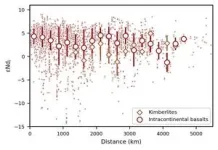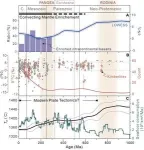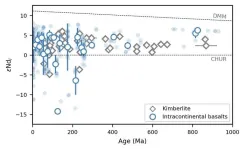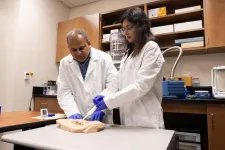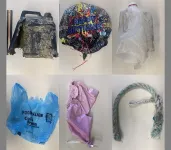(Press-News.org)
Neural spheroids — 3D clusters of brain cells — are emerging as essential tools for understanding neural networks and studying neurological diseases in the lab. EPFL’s e-Flower, a flower-shaped 3D microelectrode array (MEA), allows researchers to monitor the electrical activity of these spheroids in a way that was previously impossible. This breakthrough, published in Science Advances, lays the groundwork for more sophisticated research on brain organoids, which are complex, miniaturized models of brain tissues.
“The e-Flower lets us record neural activity from much more of the surface of neural spheroids in real-time — something that wasn’t possible with earlier tools. Our flexible technology makes it possible to get accurate recordings without damaging the 3D neural models, giving us a better understanding of how their complex circuits work,” says Stéphanie Lacour, lead author of the paper and head of the Laboratory for Soft Bioelectronic Interfaces (LSBI) at the Neuro X Institute.
Why neural spheroids?
“We focused on neural spheroids for this study because they provide a straightforward and accessible model,” says Eleonora Martinelli, one of the lead researchers on the project.
Neural spheroids are three-dimensional clusters of neurons that replicate some of the key functions of brain tissue. They are simpler than organoids, which contain multiple cell types and more closely mimic the brain. The LSBI team at Campus Biotech worked in collaboration with Luc Stoppini and Adrien Roux at the Tissue Engineering Laboratory (HEPIA-HESGE), researchers with long-standing experience with neural spheroids electrophysiology.
“Spheroids are relatively easy to produce and manipulate in the lab, which makes them ideal for early-stage testing,” Martinelli continues. “However, our goal is to eventually apply the e-Flower to brain organoids, which more accurately model brain development and disorders.”
“Organoids represent an exciting interface both for neuroscience research and next-generation neurotechnology,” says Stéphanie Lacour. “They bridge the gap between simplified in vitro models and the complexities of the human brain. Our work with the e-Flower is a critical step toward being able to explore these 3D models.”
The serendipity behind the innovation
Interestingly, the e-Flower was born out of an unexpected discovery. Outman Akouissi, a collaborator on the project, encountered a challenge while working on soft implants for peripheral nerves: the hydrogels he used caused his devices to curl unpredictably when exposed to water. What started as a frustration turned into a breakthrough when Akouissi and Martinelli realized this curling mechanism could be harnessed for a completely different application — wrapping around neural spheroids.
“This was a perfect example of how serendipity can lead to innovation,” says Martinelli. “What was originally a problem for one project became the solution for another.”
A new approach to neural electrophysiology
The device consists of four flexible petals equipped with platinum electrodes, which curl around the spheroid when exposed to the liquid that supports the cell structure. This actuation is driven by the swelling of a soft hydrogel, making the device both gentle on the tissue and easy to use.
Designed to be compatible with existing electrophysiological systems, the e-Flower offers a plug-and-play solution for researchers, avoiding the need for complex external actuators or harmful solvents.
Once the technology is applied to organoids, the ability to record electrical activity from all sides will provide a much more comprehensive understanding of brain processes. Researchers hope this will lead to new insights into neurodevelopment, brain injury recovery, and neurological diseases.
END
A study published in the journal Science Advances suggests that global fish farming, or aquaculture, may rely on significantly larger quantities of wild-caught ocean fish than previously calculated. The study is part of a special issue focused on expanding contributions from the aquaculture industry to food systems with an aim towards sustainability.
These findings call into question long-held assumptions about the sustainability of the rapidly growing aquaculture industry and provides a range of plausible estimates for its impact on wild fish populations.
The research, led by an international team of scientists ...
A collaborative effort between investigators at the National Institutes of Health’s National Institute of Allergy and Infectious Diseases (NIAID) and Massachusetts General Hospital (MGH), a founding member of the Mass General Brigham healthcare system, demonstrates the potential of precise genome editing technologies, called adenine base editors, to correct disease-causing mutations in stem cells from patients with X-linked chronic granulomatous disease (X-CGD), a rare genetic disorder characterized by high susceptibility to infections. The findings are published in Science Translational Medicine.
Patients with ...
On present-day Earth, plate subduction continuously modifies the chemical composition of the convecting mantle, and various mantle sources linked to these processes have been widely studied.
However, when did global chemical heterogeneity of the convecting mantle first emerge in Earth's geological history? And how might Earth’s geodynamic evolution have influenced the chemical composition of the convecting mantle over time?
Researchers from the Institute of Oceanology of the Chinese Academy of Sciences (IOCAS), along with collaborators from Australia, Switzerland and the USA, have tried to address these questions ...
Multilingual students face unique challenges that can hurt their performance in school. New methods of teaching may help close this gap, according to a new study from the University of Georgia.
In the United States, English is the main language used in classrooms. Schools also tend to rely on spoken communication to teach and written exams to assess learning.
That can make it difficult for multilingual students to express themselves. This is especially true in science classes, with their specific terms and complex sentence structures.
So a UGA researcher developed an immersive virtual reality game to communicate scientific ...
Video available here.
Without proper medical invention, injuries sustained from traffic collisions, serious workplace accidents or weapons may result in fatal hemorrhaging.
University of Central Florida researchers aim to prevent such bleeding in potentially deadly situations with a new hemostatic spongelike bandage with antimicrobial efficacy that they recently developed and detailed in a newly published study in the journal Biomaterials Science.
“What happens in the field or during an accident is due to heavy bleeding, patients can die,” says Kausik Mukhopadhyay, assistant professor of materials ...
When an election result is disputed, people who are skeptical about the outcome may be swayed by figures of authority who come down on one side or the other. Those figures can be independent monitors, political figures, or news organizations. However, these “debunking” efforts don’t always have the desired effect, and in some cases, they can lead people to cling more tightly to their original position.
Neuroscientists and political scientists at MIT and the University of California at Berkeley have now ...
Identifying whether online information is faulty or ungrounded is important to ensure information integrity and a well-informed public. This was especially challenging during the COVID-19 pandemic when misinformation spread like wildfire across the Internet. A new project led by Dong Wang, associate professor in the School of Information Sciences at the University of Illinois Urbana-Champaign, will integrate diverse human and machine intelligence to examine multimodal data (e.g., text and image) that was produced during the pandemic. ...
BEAUFORT, N.C. -- To whales that hunt with soundwaves in the lightless depths of the ocean, a torn plastic party balloon and a delicious squid seem to be remarkably similar, according to a new study that put some plastic beach trash through underwater acoustic testing.
"These acoustic signatures are similar, and this might be a reason that these animals are driven to consume plastic instead of, or in addition to, their prey," said Duke University graduate student Greg Merrill, who led the research.
"One hundred percent of plastic marine debris ...
How can we engineer materials that are stronger and lighter? What about new materials for extreme conditions such as in jet engines and spacecrafts?
The answer, says Fadi Abdeljawad, an associate professor of materials science and engineering in Lehigh University's P.C. Rossin College of Engineering and Applied Science, might be hidden in the infinitesimally tiny regions, or boundaries, where atoms in crystals come together.
Along with his collaborators at the U.S. Department of Energy's Center for Integrated Nanotechnologies (CINT), Abdeljawad is uncovering how those ...
Washington, D.C. (October 16, 2024) – For the first time, adults living with congenital heart disease (CHD) now have valuable insights into their long-term quality of life through data from the Congenital Heart Initiative (CHI). CHI is the nation’s first and largest patient-focused registry for adults with CHD and released its first study involving over 4,500 participants from all 50 states.
This research, published today in JAMA Network Open, marks a significant step forward in making better information available for the ...

